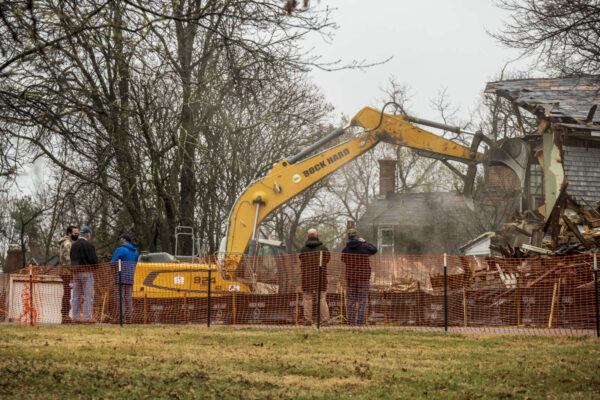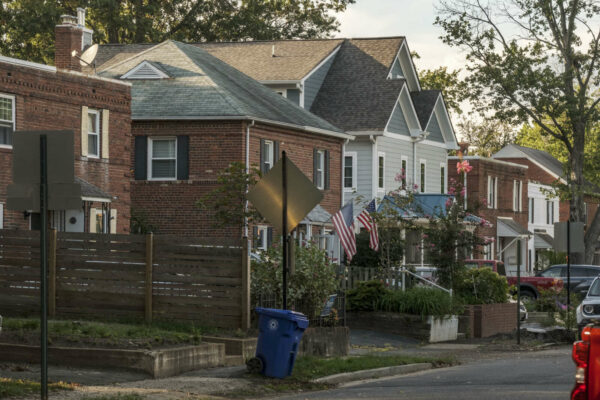
Virginia’s U.S. senators are throwing their weight behind a bill to support first-generation homebuyers.
The Downpayment Toward Equity Act would provide grants of up to $20,000 to support socially and economically disadvantaged homebuyers. Sens. Mark Warner and Tim Kaine are co-sponsoring the bill, alongside several fellow Democrats, saying this will help close equity gaps.
Housing experts warn, however, that substantially changing who can afford to buy in a pricey, competitive housing market like Arlington will probably require a combination of approaches.
“It helps. Of course it helps,” said Alice Hogan, a housing policy consultant with the Arlington branch of the Northern Virginia Affordable Housing Alliance. “But in a market like this, it’s not going to have the impact that it would have on other parts of the state.”
The proposed $100 billion federal appropriation would help a subset of homebuyers with expenses including down payment costs, closing costs and costs to reduce interest rates, according to a press release. It would be distributed through the U.S. Department of Housing and Urban Development.
“Homeownership is one of the most powerful pathways to accumulate wealth, but first-generation homebuyers — predominantly people of color — still face steep obstacles to achieving it and punching their ticket to the middle class,” said Warner. “The Downpayment Toward Equity Act could serve as a powerful tool to level the playing field, close the racial wealth gap, and help more families achieve their American Dream.”
In a housing market as expensive as Arlington, $20,000 grants would probably cause “a marginal increase” in who can afford to buy a home, said Michael Spotts, director of real estate development at Habitat for Humanity of Washington, DC and Northern Virginia. Grants could also help purchasers retain some cash reserves after buying a home, which plays a role in ensuring that people can sustain homeownership.
But in Spotts’ view, the main problem is Arlington’s housing stock.
“Ultimately, inventory is the binding constraint in Arlington,” he said. “If we want to support homeownership across the income spectrum and for those that have faced discrimination in the housing market, we need to increase the number of attainably-priced homes on the market.”
Hogan pointed out that some homebuyers may draw on multiple funding sources, such as Arlington’s Moderate-Income Purchase Assistance Program. This kind of “layering” is a more likely path toward homeownership for lower-income people in this county.
“In a market like this, alone, [the bill] wouldn’t do very much,” Hogan said. “It has to be in combination with other programs.”
In 2022, the county issued 13 MIPAP loans to people buying homes that cost less than $500,000. As housing costs continue to increase, some advocates say a revamp of the program is overdue.
Kaine said this bill could help fight discriminatory housing practices, the impacts of which he witnessed as a fair housing attorney earlier in his career.
“While we’ve made significant progress in combating discriminatory policies since then, their lasting effects continue to be evident in the wide homeownership and wealth gaps that people of color face,” the senator said. “The Downpayment Toward Equity Act would take a substantial step in addressing these gaps, by helping first-generation homebuyers overcome the disadvantages they face when trying to purchase a home.”
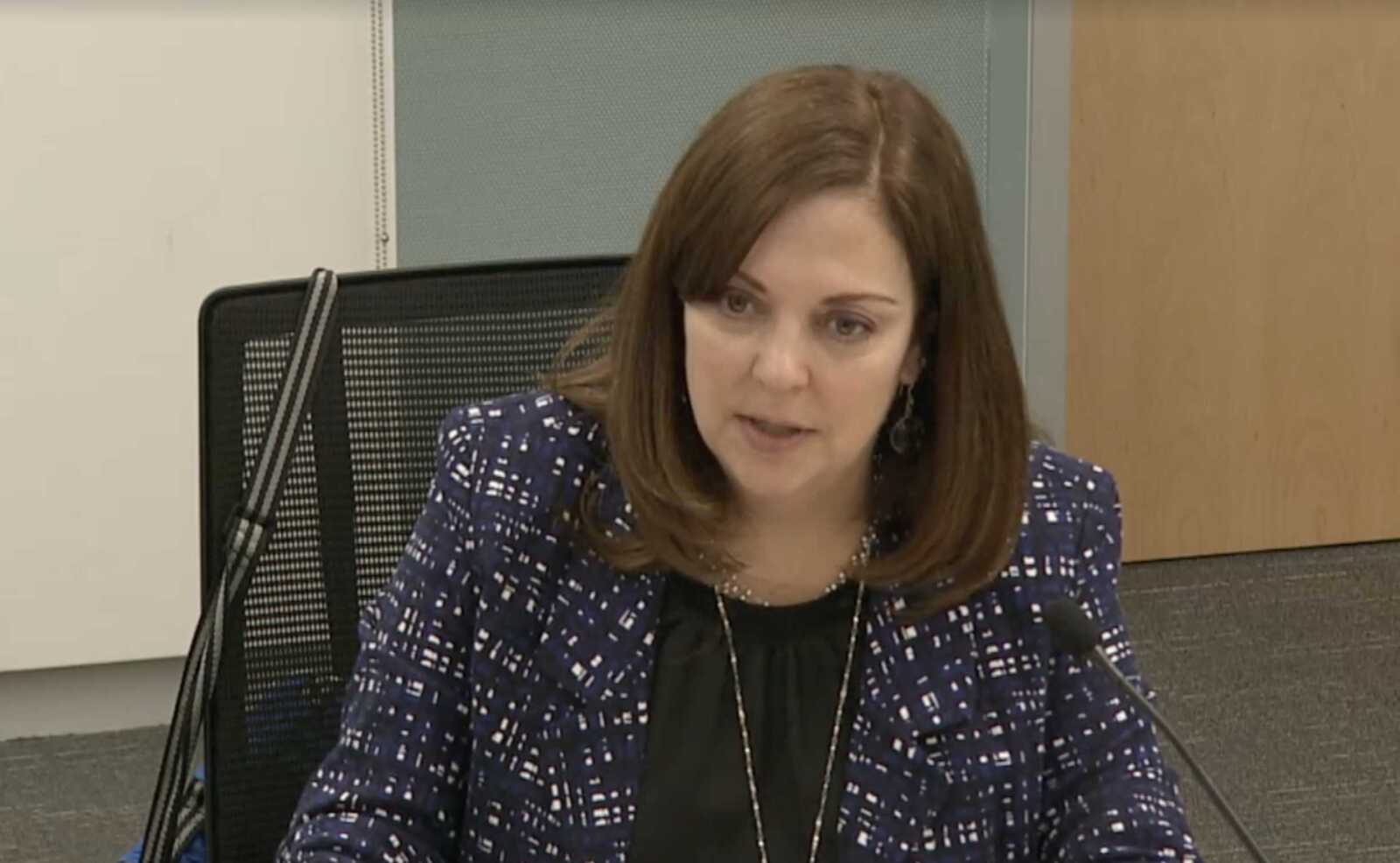
(Updated at 6:35 p.m.) Black and Hispanic students remain more likely to be suspended from Arlington Public Schools than their peers, according to new data.
Specifically, Black students make up 11% of students yet 30% of suspensions, while Hispanic students make up 30% of the population and 45% of suspensions, per a presentation to the Arlington School Board yesterday (Tuesday).
Meanwhile, students with disabilities and those learning English are also over-represented in suspension rates. APS says they are, respectively, 2.5 and 1.5 times more likely to be suspended than their counterparts.
APS has made some inroads, noting a 5-percentage point drop in suspensions of Black students, a 4-percentage point drop among students with disabilities and a 2-percentage drop among males. Suspensions rose 2 percentage points for Hispanic students and females and remain unchanged for English-language learning students.
Disproportionate suspensions along race and ethnicity, ability and sex have long existed in APS, which has recently taken steps to reduce these gaps and improve its school climate more broadly.
This includes staff training in implicit biases and the root causes of problematic student behavior as well as in how to prevent crises using de-escalation. Also, the School Board two years ago voted to remove School Resource Officers from school grounds to tackle disproportionate arrest rates among non-white students.
More recently, APS hired six Deans of Students this school year to address student behaviors at Yorktown, Washington-Liberty and Wakefield high schools as well as three middle schools. Middle schools in particular have seen problematic student behavior, including fights and verbal threats to teachers.
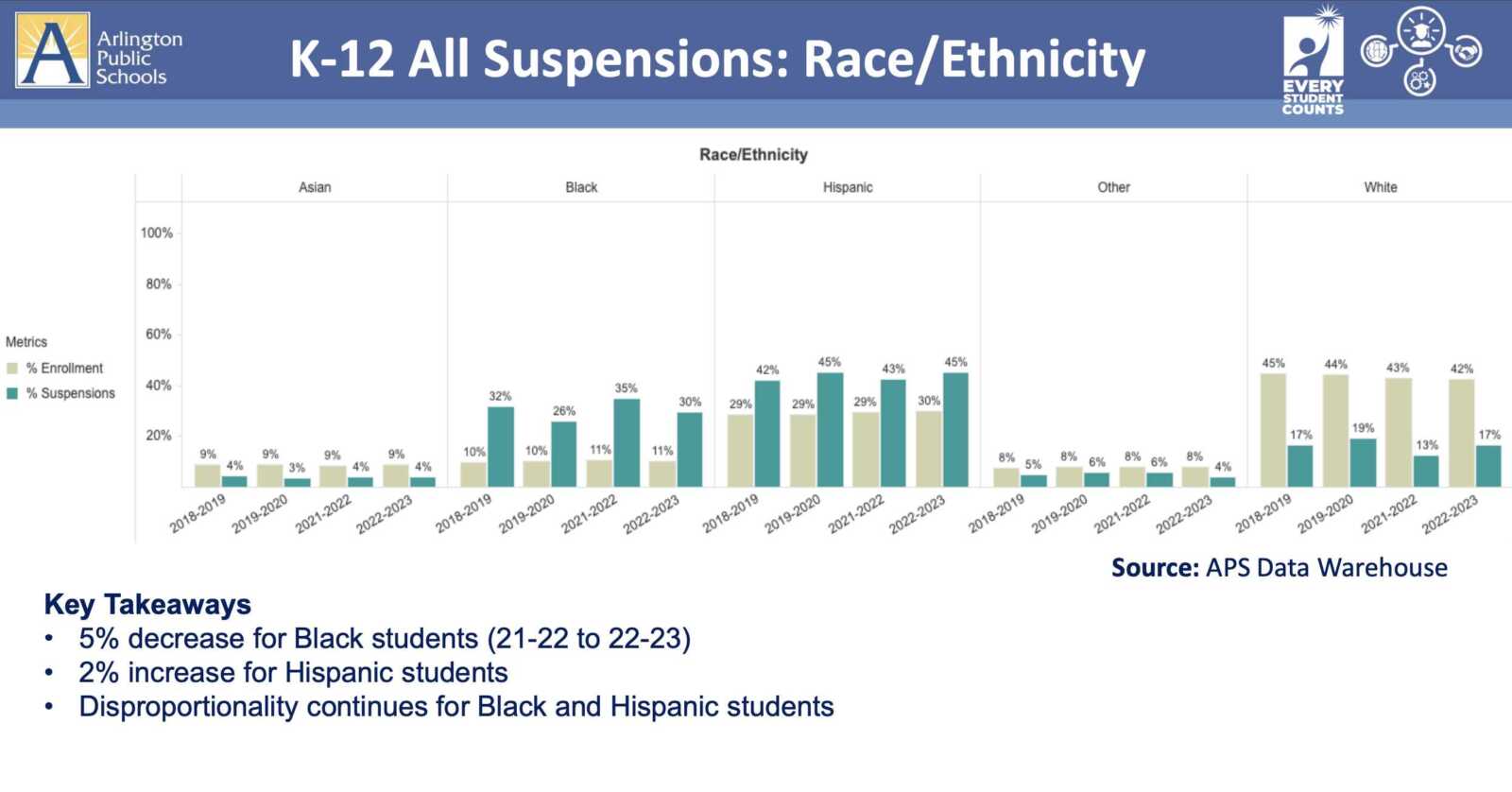
Chief Diversity, Equity and Inclusion Officer Julie Crawford described to the School Board how school administrators plan to tackle suspension rates.
“We would like to continue to focus on building our alternatives to suspension at the school level,” she said, adding that the new deans work “to proactively program and build relationships using instructional time, as opposed to removing our students from the school.”
Sometimes, students have to be removed from school. APS says the top reasons for out-of-school suspensions are disruptive behavior, followed by attendance issues — such as skipping class — and drug offenses. The top two reasons for in-school suspensions are the same, followed by fighting.
Tiffany Woody-Pope, dean of students at Thomas Jefferson Middle School, emphasized the importance of good staff-student relationships.
“I think the more that we are intentional about developing our interpersonal relationships with our students, the more comfort they’ll feel in classrooms — so they won’t necessarily have to be classified as ‘disruptive behavior,'” she said.
Seeing “disruptive behavior” top charts set off alarm bells for School Board member Mary Kadera.
“Disruptive behavior gives me a little heartburn… because historically, and broadly, outside of Arlington, ‘disruptive behavior’ has been a catch-all for a wide variety of behaviors and self-expression of students that a teacher may not like,” she said.
Crawford noted it is a broad definition with any of 17 different indicators, including disrespect and defiance.
June Prakash, the president of the teachers union, Arlington Education Association, would also like to see more daylight on “disruptive behavior,” questioning whether teachers and administrators have the ability to record a more accurate, specific reason for removing a student from class.
“Believe it or not, educators will put up with a lot before sending calling for help,” she said. “Staff often don’t feel supported, as it feels like their expertise is disregarded in the building.”
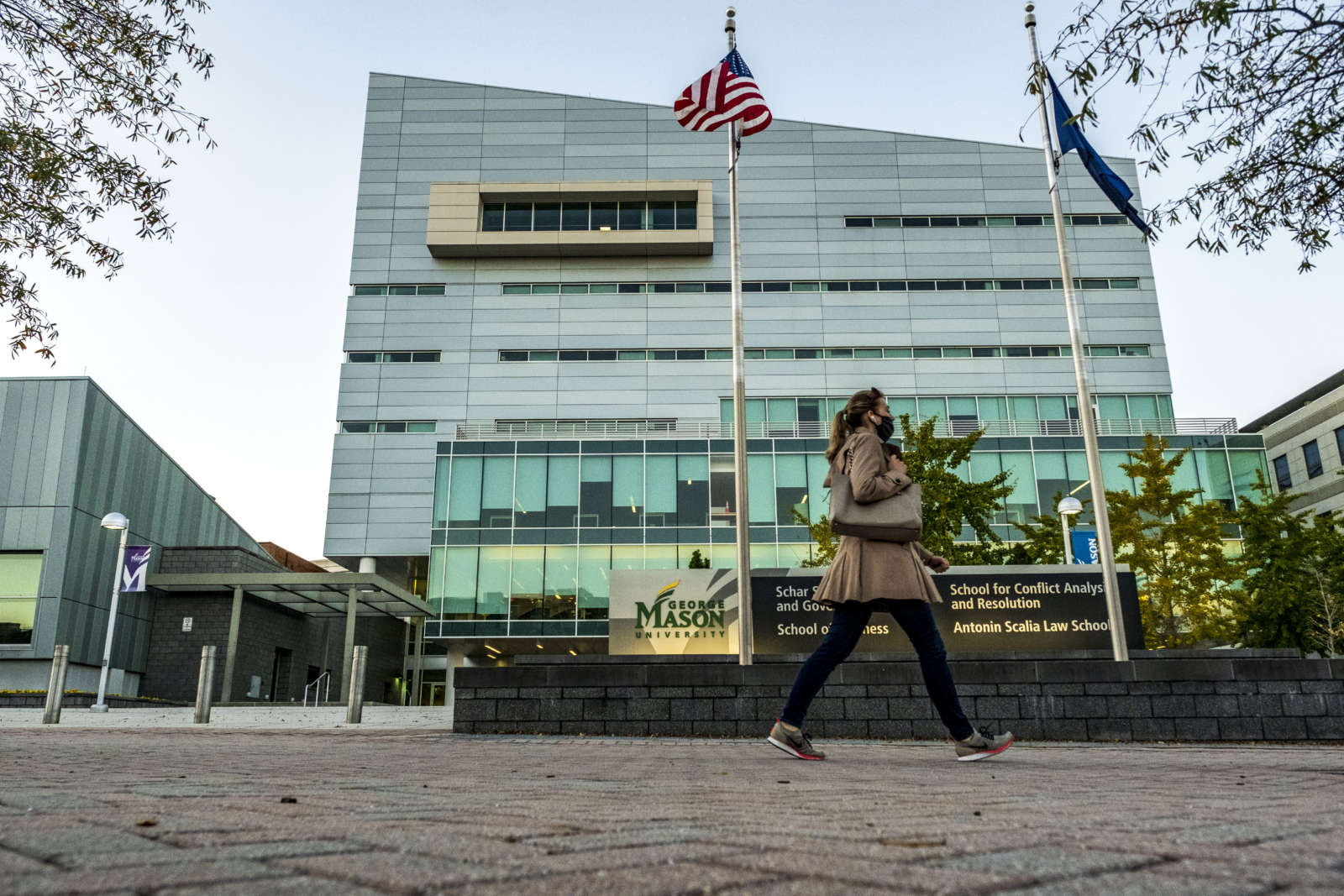
George Mason University is set to receive a $25,000 grant from Arlington County to study Black demographic shifts and migratory trends in Arlington.
The Fairfax-based university, which has a campus in Arlington, proposes to develop a “database of research that documents Black displacement, migration, mobility, and the legacy of the Black diaspora that remains today in Arlington County,” according to a county report.
GMU envisions the database serving as a “significant learning source for Arlington and lead to future meaningful artistic projects focused on African American history,” the report says.
A team comprising GMU’s University Curator, Don Russell, visual artist Veronica Jackson, as well as several university librarians and historians, will sift through hundreds of primary documents to create the database.
This includes:
[M]aps, oral histories, census data, photographs, historic Black newspapers, travel guides, land surveys, Black businesses, real estate transactions, churches, cemeteries, schools, and related examples of Black cultural life in Arlington County, historically and contemporarily.
The grant is part of Arlington’s Historic Preservation Fund. It was established in April 2022 to support individual and community-led projects that preserve “Arlington’s history, built environment, or cultural heritage” per a county webpage.
In December, the County Board approved a form for applicants seeking either a $25,000 non-capital grant or a $100,000 capital grant. This June, GMU secured a grant earmarked for projects such as historical research and educational outreach.
The university, however, says it cannot agree to the terms of the grant as written, and is requesting a few changes. These changes are set to go before the County Board for approval this weekend.
GMU requests new wording clarifying it, as a public university, is not responsible for the county’s legal fees if the county faces a lawsuit. It also requests the ability to use the funds for an extra 90 days after the current deadline of June 30, 2024.
The university expects about $8,000 would go toward personnel costs, nearly $6,000 toward travel expenses and nearly $11,000 for general costs, including equipment, supplies and an artist fee for Jackson’s work.
Eleven other organizations and people received grants for capital projects — such as restoration, cleaning and repairs — and non-capital projects, says Historic Preservation Program Coordinator Cynthia Liccese-Torres.
She told ARLnow the county plans to share more details “once all of the grant agreements have been finalized and signed by all parties.”
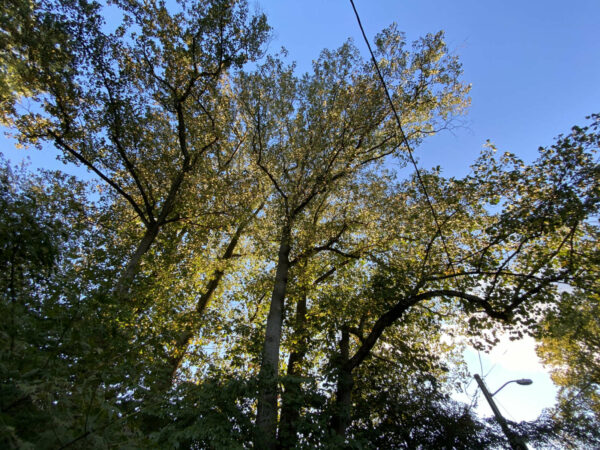
EcoAction Arlington just got a $60,000 boost from the Arlington branch of the NAACP and the Mormon church in its efforts to plant trees in disadvantaged neighborhoods.
Last year, the environmental advocacy group announced its plan to plant trees in 10 neighborhoods where the canopy is thinner than elsewhere — areas generally less wealthy and more diverse than Arlington’s leafier enclaves. The 2022 announcement coincided with a $50,000 donation from Amazon.
The initiative, dubbed the Tree Canopy Equity program, aims to raise $1.5 million to fund planting 250 trees twice a year, for the next five years — or 2,500 trees total. Last week, the NAACP announced it had selected EcoAction Arlington to receive the money through a strategic grant and partnership with The Church of Jesus Christ of Latter-day Saints.
“Arlington has a 10-year life expectancy difference amongst its neighborhoods, and this donation will create focus and provide much-needed tree canopy in places that have, for decades, been left out of the conversation,” NAACP Branch President Michael Hemminger said in a statement. “For years, EcoAction Arlington has been a committed partner in the furtherance of our mission, making them a natural fit for why we selected this non-profit as the recipient.”
To date, EcoAction Arlington has raised $239,000 from individuals, corporations, nonprofits, foundations and the state of Virginia, executive director Elenor Hodges tells ARLnow.
“That’s got to be a record for us in most money raised in shortest amount of time,” she said. “We’re truly grateful to the NAACP and looking to them as a true partner.”
The money funds outreach needed to find residents, apartment buildings and organizations interested in planting trees. It also pays for shrubs — trees are paid for through the Arlington County Tree Canopy Fund — and, in some cases, water.
Hodges says she is excited to use support from a foundation to pay community members to do the outreach work, similar to a model used in Wards 7 and 8 in D.C.
“This community work takes people, time and money, so we want to pay people and professionalize it,” she said.
This spring, volunteers planted 215 trees and 110 shrubs across the 10 neighborhoods, particularly in Penrose, Green Valley and Aurora Highlands, she said. Shrubs provide the benefits of trees and are ideal for people without the space for a tree or who are not ready to add one to their yard.
The 10 neighborhoods being targeted have a lower average tree canopy than Arlington County as a whole, according to one study funded by some members of local environmental advocacy groups, including EcoAction Arlington.
Based on imaging from 2021, a consultant found that trees cover 33% of land — excluding the Pentagon and Reagan National Airport — down from 41% on the same land six years ago. The 10 neighborhoods, meanwhile, have a canopy coverage average of 22.6%.
The neighborhoods and their canopy levels are as follows:
- Arlington View, 17%
- Aurora Highlands, 22%
- Buckingham, 21%
- Columbia Heights, 28%
- Glebewood, 29%
- Green Valley, 24%
- John M. Langston Citizens Association, 19%
- Long Branch Creek, 24%
- Penrose, 23%
- Radnor/Fort Myer Heights, 19%
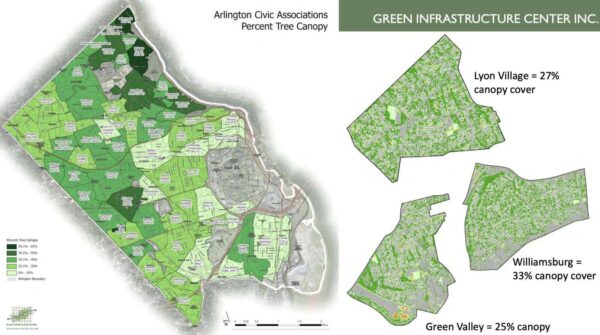
The absence of trees makes a neighborhood hotter and Arlington’s hottest places are along the Rosslyn-Ballston corridor and near Reagan National Airport, per a study by Marymount University.
Study authors say this is because concrete and asphalt absorb heat and radiate it back into the environment while neighborhoods in North Arlington have more trees and gardens to soak up that sunshine.
(Updated 03/29/23 at 4:30 p.m.) The next batch of neighborhood-level improvement projects is headed to the Arlington County Board for approval.
These include installing new LED streetlights along 35th Street N. in the Rock Spring neighborhood, fixing a missing sidewalk link along a street in Alcova Heights, and improving two parks — one in South Arlington and one in North Arlington.
The four were winnowed down from nearly 60 prospective projects. Of them, one — improvements to Baileys Branch Park in Columbia Forest — meets new equity criteria that the Arlington Neighborhoods Program says it has started using to evaluate worthy projects.
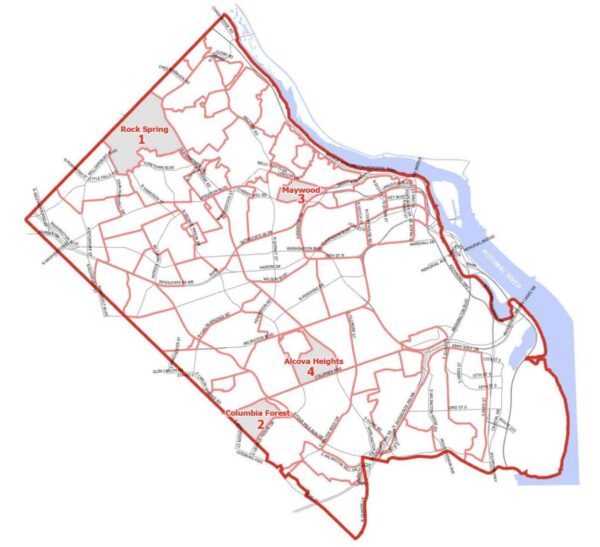
For decades, this program has served as a community-driven process by which residents can identify small-scale infrastructure projects that are vetted and then recommended to the Arlington County Board for approval. A long-standing criticism has been that this process favored wealthier neighborhoods where residents had the time, resources and connections to be more civically engaged.
Last year, the Arlington Neighborhoods Advisory Committee struck “conservation” from its name, saying it connotes exclusivity, and added equity criteria to how it evaluates projects. At the start of this year, the Arlington County Board welcomed these changes to “embrace equity.”
The new criteria are two-fold: first, whether the neighborhood has a high population of people of color, and second, whether it has high rates of poverty and lower rates of higher education, homeownership and English proficiency.
“The equity considerations are a work in progress and will be evaluated and refined as needed over time,” per the report.
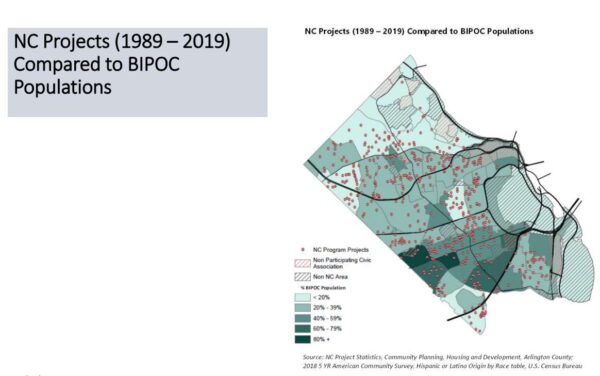
More details about the project are as follows.
- 35th Street N. from Little Falls Road to Williamsburg Blvd, in Rock Spring, is going to get new, “cobra-style” LED streetlights for $268,710. Road safety is a particular concern in this part of residential North Arlington. This stretch is a few blocks from where Washington-Liberty High School student Braylon Meade was killed by a teen accused of drunk driving.
- Bailey’s Branch Park (990 S. Columbus Street), a 2-acre park with a playground and green space in Columbia Forest, will get $750,000 in improvements, including the removal of invasive plants, additional native trees and plantings, new site furnishings and park signage.
- After invasive plants are removed from Thrifton Hill Park, new site furnishings, a picnic shelter and potentially, a dog run will be added. This will cost $985,000. The park at 2814 23rd Street N. in the Maywood neighborhood has trails and provides access to Custis Trail.
- A missing sidewalk link, with crosswalks and ramps that are accessible to people with disabilities will be installed along a 200-feet stretch of 7th Street S., near where it curves and intersects with 8th Street S. in the Alcova Heights neighborhood. This street improvement will cost $342,741.
The recommended projects went through the standard public engagement process for Arlington Neighborhoods Program, according to the county report, described as a “collaborative effort that seeks input from residents and civic associations on concept designs.”
The Rock Spring and Alcova Heights projects went through a two-step petitioning effort for affected residents and received the necessary support to qualify.
“The Columbia Forest and Maywood park projects were approved by their civic associations at one of their advertised meetings,” the report says. “All four civic associations continue to support each of the projects in their respective neighborhoods.”
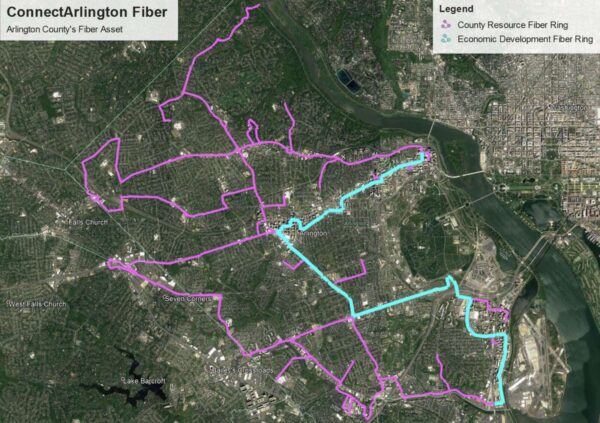
Arlington County is surveying residents and businesses to understand how they use broadband internet service and if their access can be improved.
The results of the survey are part of a $250,000 study that could inform ways to bridge the digital divide between residents with good internet connectivity and those without it, using the county’s existing fiber-optic network, dubbed ConnectArlington.
“The Broadband study builds off past work to fill in information gaps and provide a clearer picture of the County’s broadband needs,” Erika Moore, a spokeswoman for Arlington County Department of Community Planning, Housing and Development, tells ARLnow.
Arlington has an extensive fiber network, which it installed seven years ago to provide connectivity for county and Arlington Public Schools facilities, support public safety needs and encourage economic development. She says this move has since saved the county money and now allows for additional uses, such as connecting traffic cameras, emergency services and colleges across the area.
Now, the county is partnering with Vienna-based consultant Televate to look at how to leverage what it has to bridge the digital divide, an issue exacerbated by the pandemic.
“Based upon gaps identified, the consultant will lay out a comparative evaluation of different service delivery models to address the County’s needs,” Moore said. “Depending upon the outcome of the study, the County may need additional analysis to further research a specific model.”
The study will also review a license agreement for leasing strands along an 864-count fiber line dedicated to economic development. The concept, intended to give local companies higher-speed internet at lower costs than big-name providers like Comcast, has languished because would-be providers found the agreement onerous. So far, only JBG Smith has agreed to lease some of the cable to help build its 5G-enabled “Smart City.”
“The likelihood of modifying the license or changing or adding other policies will be considered after the results of the study,” Moore said.
The survey, available now in English and Spanish, asks people a few dozen questions about internet use. Questions include how long respondents have used the internet and how much it contributes to their jobs, whether they use broadband for telehealth services, if they’re satisfied with the speed and cost, as well as demographic questions.
Moore says the county has studied the digital divide before but not on this comprehensive of a scale. Past research targeted low-income housing and relied on Federal Communications Commission and U.S. Census data.
This “did not provide the level of detail needed and gave no indication of service quality, bandwidth availability, provider competition, or digital literacy needs,” she said.
A coalition of local advocates for making broadband a county-provided utility say the scope seems redundant given past efforts, however.
“The county has studied the digital divide to death. We have good numbers on that,” says ArlFiber Collective leader Tim Dempsey, adding that ironically, the survey is long and only available online.
“Televate LLC, does not appear to be interested in seriously studying municipal broadband and the current course and scope of the study could very well reproduce the same work on broadband that has been done in the past, without moving us forward in any meaningful way,” ArlFiber wrote on its website. “Residents and civic groups that are interested in community broadband for all, should reach out to the County Board members and let them know.”
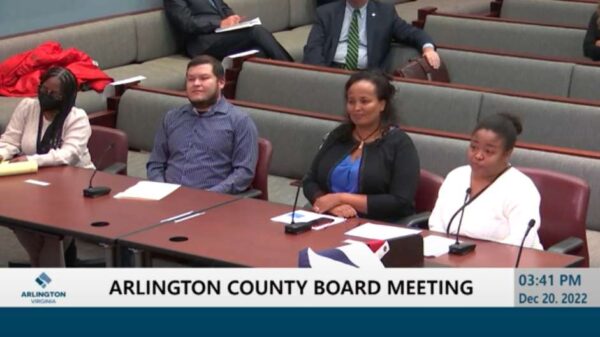
The informal, relationships-based advocacy at the core of the “Arlington Way” makes it harder for nonprofits led by and serving people of color to receive county funding, Arlington County Board Chair Katie Cristol says.
She tells ARLnow these concerns were raised by leaders of color, and she is working on a resolution — that could be voted on by the County Board this month — to change the status quo. The resolution will incorporate recommendations made by a small group of leaders representing local nonprofits.
At the top of their list is a fairly simple concept: a formal application process. Right now, Cristol says, the county uses an “ad hoc” process that doesn’t “live up to our values of transparency and access.”
Meanwhile, a decades-old, community-based program that identifies small infrastructure improvements is confronting a longstanding criticism — which leadership says is backed up by fresh data — of favoring projects in wealthier, whiter neighborhoods.
Community leaders presented updates on these efforts to the Arlington County Board last month. The moves are part of the county’s work to apply its 2019 equity resolution to policy-making and the newest contribution to the Board’s ongoing discussion of problems with the “Arlington Way,” the moniker given to the public process that informs policy-making.
The process often rewards those who are most civically active, connected and vocal about a given issue. But not always: it also frustrates those who follow the civic engagement playbook only to have the Board vote the other way.
“We heard some truthful feedback about how the ‘Arlington Way’ — for the many things it has achieved and its, at times, positive contributions to the community — also has some real downsides,” Cristol said in the Dec. 20, 2022 meeting. “It has been a way of doing things that lacked transparency and access, has prioritized relationships over fairness, and at times, it feels like it is reflective of predetermined outcomes.”
As part of the annual budget, the county awards grants of up to $50,000 or $100,000 for nonprofits serving low- and moderate-income residents, such as employment programs for people with disabilities, after-school programming for immigrant youth and financial planning assistance for families at risk of homelessness.
Leaders of local organizations say the county needs to do a better job of publicizing when funding is available and helping grassroots groups with the application process.
“This part was important for us, particularly for smaller organizations who don’t necessarily have the bandwidth or knowledge in the grant-making cycle that other larger organizations have,” said Cicely Whitfield, the chief program officer for the homeless shelter Bridges to Independence.
This could involve providing clearer deadlines and technical assistance, as well as feedback and workshop opportunities for nonprofits that are denied funding so they can apply successfully.
The group says the county should defer to organizations, which have a better sense of what the community needs, and ask for input on applications from people who would benefit.
Board Member Libby Garvey supported the changes but warned they could be controversial.
“There’s that saying, ‘I’m here from the government and I’m here to help you,’ and that’s supposed to be scary. It’s really because what it often means is, ‘I’m here from the government and I’m here to tell you what you need.'”
The sentiment applies to the Arlington Way, she says.
“We may find a little reaction from this, that ‘This is not the Arlington Way,'” she said. “We’re going to have to figure out ways to bring along everyone and explain… ‘This is going to be better and here’s why.’ We’re going to have work to do with the other part of the community that maybe is usually included.”
There is a three-decade-old program where the county acts on needs identified by residents: the Arlington Neighborhood Conservation Program, now known as the Arlington Neighborhoods Program (ANP).
The downside of this program is that it has “equity liabilities,” County Board Member Takis Karantonis said.
He said the model works for “community members who could afford to go to the meetings, who could afford to make a methodical evaluation of the state of sidewalks, or lack of sidewalks, or lack of public lighting… and fight for funding in a competitive but orderly manner.”
Although not a new criticism, ANP Chair Kathy Reeder provided the County Board with new data suggesting the program has disadvantaged less wealthy, more diverse neighborhoods.
A proposed left-turn lane off of N. Glebe Road in Ballston could be the smallest, yet most scrutinized traffic change in 10 years.
As part of the planned redevelopment of the Ballston Macy’s, Insight Property Group proposes to add a left-turn option at the intersection of 7th Street N. and N. Glebe Road. It will be for drivers going southbound on Glebe who want to turn onto a proposed private drive abutting the planned grocery store, which will be located at the base of Insight’s proposed 16-story, 555-unit apartment building.
“It was the most thoroughly vetted transportation scenario in the time that I’ve been with Arlington County,” transportation planner Dennis Sellin, who has worked with the county for 10 years, told the Planning Commission last night (Monday).
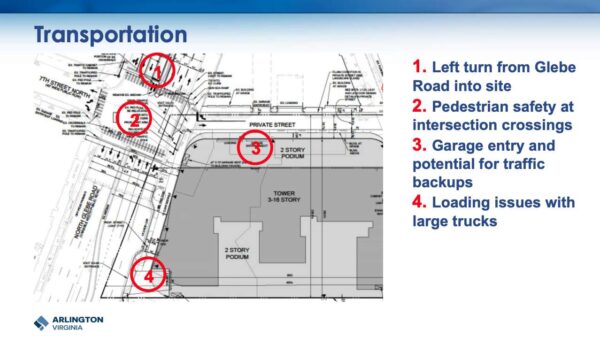
During the meeting, the Planning Commission gave a green light to the redevelopment, which will go before the Arlington County Board for approval later this month.
After the Transportation Commission voted to defer the project solely on the basis of the left turn, Planning Commission members supported a condition for the project that county staff work with Insight and the Virginia Department of Transportation to come up with more pedestrian-oriented options for the intersection.
“I do not think it’s reasonable to hold up the project for this, given that there’s apparently continued good faith work on the intersection to improve its pedestrian-friendliness,” Commissioner Jim Lantelme said. “I want to make clear that the Planning Commission… expects that any option possible to make this intersection more pedestrian-friendly will be pursued.”
Sellin said a half-dozen staffers, including two top transportation officials, have thoroughly vetted the left-turn lane. They published a 64-page memo justifying the turn lane and will study how the grocery store changes traffic before adding any pedestrian mitigation measures.
“There’s a recommendation to not allow any right turns on red at any of the lights in the intersection,” he said. “That’s a movement we’ll take under further consideration. Our primary concern is safety, our secondary concern is operations.”
The left-turn lane is a non-negotiable for the grocer, who has otherwise been “insanely flexible” as the project has changed throughout the public process, according to Insight’s Managing Principal Trent Smith.
“We’ve shrunk their store, changed their ramps, taken away their parking… we changed their loading, we’ve done eight or nine things that took all sorts of reworking and they’ve stuck with us and have been great, reasonable partners throughout,” Smith said.
Insight’s attorney, Andrew Painter, says the unnamed grocer required the left turn based on “decades of experience in urban configurations.” He added that for a decade, the grocer has desired to be in Ballston, which already has a Harris Teeter nearby on N. Glebe Road, a quarter-mile away.
Some Planning Commissioners noted their regret that the project does not do more to provide on-site affordable housing.
“This space here, in the heart of Arlington, in Ballston, where there’s access to transit, and now a grocery store, we have nothing,” Commissioner Devanshi Patel said.

A new program seeks to increase equity in Arlington by planting more trees in certain neighborhoods.
The local non-profit EcoAction Arlington announced that it’s starting the “Tree Canopy Equity Program” with the goal of raising $1.5 million to fund planting at least 2,500 trees over the next five years in local neighborhoods that have too few.
Insufficient tree canopy is closely tied to heat and temperature increases. The reason certain areas of Arlington are hotter than others, like the Rosslyn-Ballston corridor, is due in part to lack of trees, recent data shows.
“The neighborhoods most impacted by insufficient tree cover are communities with higher-than-average minority populations and communities with people living in poverty,” EcoAction Arlington said a press release. “The lack of trees has a real-world impact that can lead to poor physical and mental health outcomes, higher utility costs, and a lower quality of life.”
The ten civic associations and neighborhoods that the program will work with are below.
- Arlington View
- Aurora Highlands
- Buckingham
- Columbia Heights
- Glebewood
- Green Valley
- John M. Langston Citizens Association (Halls Hill/High View Park)
- Long Branch Creek
- Penrose
- Radnor/Fort Myer Heights
The current levels of tree cover in those neighborhoods is between 17% and 33%, according to EcoAction Arlington.
“The goal is to radically increase tree planting in the neighborhoods with the lowest tree cover to align with the average for other Arlington communities of approximately 40 percent,” the press release says.
EcoAction Arlington executive director Elenor Hodges tells ARLnow that that the group has already begun to plant more trees. That includes American hornbeams, pin oaks, river birch, sugarberry, American sycamore, swamp white oak, and American linden.
The program needs about $150,000 a year to cover operations, marketing, staffing, and the actual planting of trees, Hodges says, with each tree costing about $500 to plant.
Amazon, an inaugural sponsor, has already contributed $50,000. The goal is to raise $1.5 million from other corporate and individual donors, while also obtaining funding from Arlington’s existing Tree Canopy Fund Program. This initiative allows neighborhood groups, owners of private property and developments, and places of worship to apply to have native plants or trees planted on their property.
Residents in neighborhoods lacking sufficient tree canopy note that the the problem is often tied to the construction of large, new homes and not prioritizing trees while building.
“As we lose trees due to infill development of large homes on lots in our neighborhood, they need to be replaced and even expanded,” John M. Langston Citizens Association president Wilma Jones tells ARLnow. “We all know that trees give off oxygen and they reduce stormwater runoff.
Natasha Atkins has been a resident of Aurora Highlands for nearly four decades and has “watched with alarm” the number of trees lost to homebuilding projects.
“With the County’s zoning code, requiring only very small setbacks for residential housing, it is questionable whether there will be much of a tree canopy in the future in the single-family neighborhoods that are being redeveloped,” she says. “Trees are an afterthought in planning and zoning. They should really be a driver.”
Hodges concedes that planting 2,500 more trees over the next five years will only “make a dent” and it will take tens of thousands of trees for all these neighborhoods to reach the 40% tree canopy threshold.
But the Tree Canopy Equity Program is just as much about what one can do today as what one can do tomorrow, says Hodges.
“It’s about behavioral change and teaching people about the importance of having a sufficient tree canopy in Arlington,” she said.
A recent survey of Arlingtonians found a majority say the county needs to be more aggressive about preserving historic buildings, monuments and resources from demolition.
Engagement in the survey, administered in 2021, was three times higher than engagement in a similar survey distributed two years ago, before the loss last year of two historic homes — the Febrey-Lothrop House and the Victorian Fellows-McGrath House — to make room for new housing.
The tripling, however, did not result in a more diverse group of respondents. More than 80% of respondents were some combination of white, homeowners and 45 years old and up.
The most recent Historic Preservation feedback form response pool is somehow even more white and more homeowner-y than the last one. This seems indistinguishable from a CivFed meeting. pic.twitter.com/JI16BJqrlY
— Chris Slatt (@alongthepike) March 24, 2022
The survey is part of a county effort to update its master plan governing historic preservation, with a new focus on equity and inclusion, says Department of Community Planning, Housing and Development spokeswoman Rachel LaPiana.
Adopted in and unchanged since 2006, the update — if adopted by the County Board by the end of 2022 — will direct the historic preservation priorities and programs for the next decade, she said.
Many respondents said the county should be highlighting century-old properties, historic neighborhoods, archaeological sites and resources connected to Arlington’s immigrant, African American and Native American communities. Some railed against the county and the plan for not preserving sites like the Febrey-Lothrop House, while a few said such teardowns are necessary to make room for more housing and affordable units.
The survey asked broad questions to understand what residents value, with questions like “what stories, traditions, places, buildings, and/or communities are important to you?”
But for some civically engaged Arlington residents, the demographics of respondents were more interesting. They say this survey yielded detailed feedback from passionate individuals but did not reveal how the broader community values historic preservation.
The problem, per Dave Schutz — a civically engaged resident and prolific ARLnow commenter — is how the survey is advertised and where. His oft-repeated remark about community engagement in Arlington: “You ask twelve guys in Speedos whether we should build [the Long Bridge Aquatics Center], you will get a twelve to zip vote yes.”
Schutz suggested the county keep track of how respondents hear of the survey, so they know whose perspectives are being captured.
“I might require that surveys… contain an identifier so that the people tabulating results could see which ones had been filled out by people who were notified through the, say, Arlington Historical Society website and which by people notified through the ‘Engulf and Destroy Developers Mwa-ha-ha website,’ the County Board website — and if the opinion tendencies were wildly different, flag it for the decision makers that that was so.”
Joan Fitzgerald, a local resident who works in surveying populations, says county survey questions are often worded to confirm the biases of the survey writers, while the questions can be jargon-dense.
“County survey questions are often confusing, and participants often need a strong background in the topic to even understand what’s being asked,” said Fitzgerald, who sits on the development oversight committee for the Ashton Heights Civic Association.
The local NAACP is calling on the Arlington County Board to do more to encourage affordable homeownership opportunities for residents of color.
Although segregation officially ended last century, the Arlington branch of the NAACP says non-white residents are still effectively excluded from some neighborhoods due to county zoning codes, compounded by rising housing costs.
“The widespread single-family zoning scheme that prevents the construction of new housing in affluent, mostly white neighborhoods also worsens racial segregation by confining the construction of new affordable housing units to the Columbia Pike corridor and other parts of Arlington with large non-white populations,” the NAACP wrote in a letter to the county.
“People of color wishing to live in Arlington deserve meaningful opportunities to choose from a wide variety of housing types, in many parts of the county, at a reasonable cost,” the letter continues.
The NAACP says the county needs to adopt a comprehensive strategy to reform the county’s zoning laws and housing policies. It suggests reforms that go beyond those being considered in the Missing Middle Housing Study.
“We support the County’s many studies and other initiatives to promote affordable housing,” it concludes. “The best way to ensure the success of these initiatives is for the County Board and County Manager to show decisive leadership now and commit to supporting comprehensive zoning reform.”
Through Missing Middle, the county is considering whether and what kind of low-density multifamily housing could fit into single-family home neighborhoods. The county says allowing more housing types in these neighborhoods can reverse the lingering impacts of yesteryear’s racist zoning policies.
“The Missing Middle Housing Study has documented the role that Arlington’s land use and zoning policies have played in contributing to racial disparities in housing and access to opportunity,” says Erika Moore, a spokeswoman for the Department of Community Planning, Housing and Development. “Conducting the Missing Middle Housing Study is one of many deliberate choices the County is making to address the mistakes of the past and pave a new path for Arlington’s future.”
While supportive of the study, the NAACP suggests solutions beyond its parameters.
It recommends every redevelopment be assessed for whether it would perpetuate historical exclusion or displace the existing community. If so, developers would have to use a “displacement prevention and mitigation toolkit” to reverse those impacts.
This toolkit could include:
- property tax deferrals for lower-income homeowners
- funding for Community Land Trust acquisitions
- preferences for first-generation homebuyers
- stabilization funds for residents at risk of displacement
The toolkit would “address the unique needs of and the displacement risk experienced by the community in and around site-plan and by-right developments while also helping to address patterns of historical exclusion experienced by members of protected classes,” the letter says.
These and other tools should also receive county and state funding, like a quick-strike land acquisition account, which would be used to quickly purchase properties for affordable housing development, and targeted homeownership assistance programs, the NAACP says.


